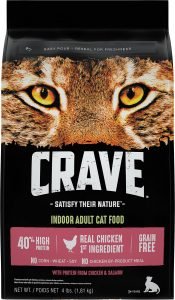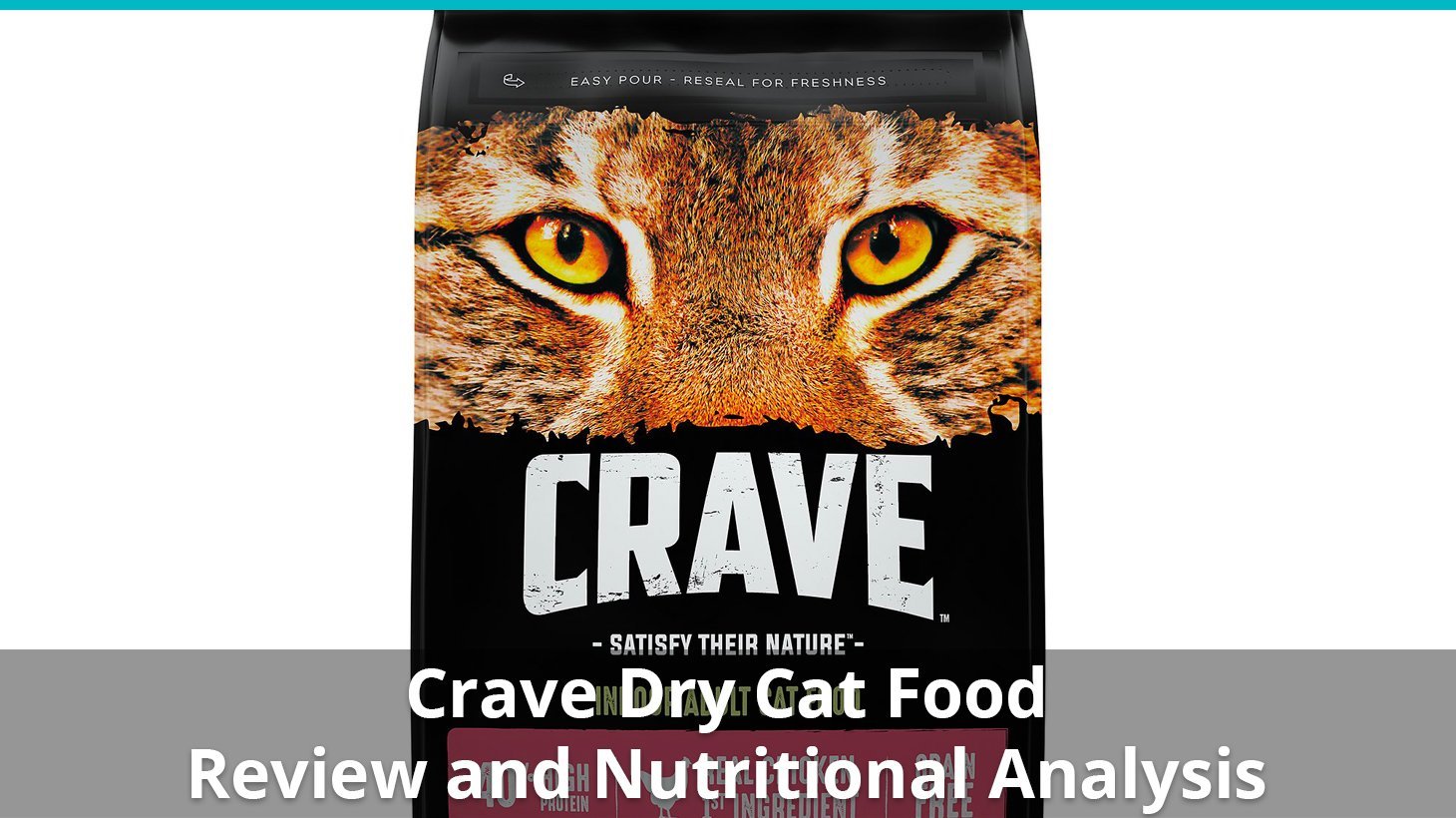Our review process is unbiased and based on extensive research. If you buy through the links on our site, we may earn a commission.
Rating
- Meat is the first ingredient – 1 Star
- Uses some unnamed meats – 1 Star
- Above average protein content – 0.5 Star
- Less than 4 controversial ingredients – 0 Star
- Catological Discretionary Rating – 0.5 Star
Here’s a few important points to consider for this particular line:
- Meat is the first ingredient
- There are a nice variety of meat products in each recipe, but also unnecessary fillers (but they are grain-free fillers)
- Includes extra vitamins, high quality, chelated versions of some minerals, and probiotics
- Protein levels are OK, carb levels are a bit high, and fat is a bit low. It is a reasonable, but not perfect macronutrient profile
The Crave product line includes 5 dry recipes/flavors.
Each recipe below includes its related AAFCO nutrient profile when available on the product’s official webpage or packaging: Growth (G), Maintenance (M), All Life Stages (A), Supplemental (S) or Unspecified (U).
The star rating is a rough average of all of the flavors in a single line of food. If an individual recipe scored lower or higher, we will mark that below, next to the flavor.
- Crave Indoor Adult Chicken & Salmon (M)
- Crave Adult Chicken (M)
- Crave Adult Salmon & Ocean Fish (M)
- Crave Adult Turkey, Chicken & Duck (M)
- Crave Kitten Chicken (G)

Crave Indoor Adult Chicken & Salmon was selected to represent the other products in the line for this review.
Crave Indoor Adult Chicken & Salmon
Dry Cat Food
| Estimated Nutrient Content |
| Protein | Fat | Carbs | |
|---|---|---|---|
| Guaranteed Analysis | 40% | 16% | NA |
| Dry Matter Basis | 44% | 18% | 21% |
| Calorie Weighted Basis | 41% | 40% | 19% |
Estimated Dry Matter Nutrient Content
Fiber (guaranteed analysis)
6%
Calories/100g
368
Is real, named meat the first ingredient?
Yes
Ingredients
Chicken, Chicken Meal, Pea Protein, Split Peas, Chicken Fat (preserved with Mixed Tocopherols), Tapioca, Dried Plain Beet Pulp, Potato Protein, Salmon Meal, Dehydrated Alfalfa Meal, Natural Flavor, Flaxseed, Potassium Chloride, Choline Chloride, DL-Methionine, Salt, Mixed Tocopherols and Citric Acid (preservatives), Taurine, Zinc Sulfate, Vitamin E Supplement, L-Ascorbyl-2-Polyphosphate (source of Vitamin C), Iron Amino Acid Chelate, Yucca Schidigera Extract, Vitamin B12 Supplement, Copper Amino Acid Chelate, Niacin Supplement, Manganese Amino Acid Chelate, Biotin, Riboflavin Supplement (Vitamin B2), D-Calcium Pantothenate, Thiamine Mononitrate (Vitamin B1), Vitamin A Supplement, Pyridoxine Hydrochloride (Vitamin B6), Sodium Selenite, Vitamin D3 Supplement, Potassium Iodide, Folic Acid, Rosemary Extract.
Ingredients in red are controversial or of questionable quality.
Ingredient Breakdown
The first ingredient in this cat food is chicken. Good.
While quality of the individual ingredient can vary, chicken is a very good protein source for cats.
It’s also important to note that chicken contains about 70% water, so when it is processed and cooked for use in cat food, it will become a smaller part of the total recipe.
The second ingredient is chicken meal. Good.
Chicken is a very good protein source for cats.
Chicken meal is a concentrated form of chicken, and is considered a high quality ingredient.
In short, much of the moisture of the chicken is taken away, and you are left with a very high-protein, low-moisture powder-like substance.
The inclusion of chicken meal helps to ensure a very high protein level.
The third ingredient is pea protein. Bad.
Peas are a quality carbohydrate, but cats don’t need much in the way of carbohydrates.
Peas are also rich in protein, and this ingredient is a concentrated form of that protein, which means the actual meat content of this food may be lower than the macronutrient profile suggests.
Peas are not the worst carbohydrate your cat can consume, but they’re simply not at all biologically appropriate.
The fourth ingredient is split peas. Bad.
Again, cats don’t need to eat peas.
They are full of fiber and protein, so again, we should keep this in mind when judging the meat content of this food against the crude protein content on the label.
The fifth ingredient is chicken fat. Good.
Named animal fats in cat food is usually a good thing. Cats do need a fair amount of fat.
Chicken fat is a great source of healthy fats and omega fatty acids.
It is preferred to canola oil or unnamed animal fats.
The sixth ingredient is tapioca. OK, but with reservations.
Used in many grain-free recipes as a starch to bind the food together.
While it’s not very nutritional and doesn’t compare well to grains in some cases, there’s likely not enough of it to cause any digestive issues for your cat.
The seventh ingredient is dried plain beet pulp. OK, but with reservations.
Beet pulp is intended to increase fiber quantities in pet foods, and may be good for intestinal health.
However, some believe it is just an inexpensive filler.
Whatever the case, we believe that a little bit in the food isn’t detrimental to your cat, but probably isn’t a necessary ingredient.
The eighth ingredient is potato protein. Bad.
Potatoes are usually used as filler carbohydrates, but potato protein is the concentrated form of potato that gives it a high protein count.
Potatoes are not biologically appropriate and may cause digestive upset.
Plant-based proteins are added to pet food in order to boost the crude protein amount on the label.
This usually means there is less meat than you expect, since the protein that you expect to come from meat, is actually coming from a vegetable source, which is not great for your cat.
This recipe includes a number of other ingredients, but once you get down this far, none of them will be in large enough quantities to make a real difference, except for the added vitamins and minerals.
However, there are a few things you should know about.
This recipe utilizes chelated minerals, which may be easier to digest and more bioavailable for your cat. This is usually a sign of a high quality cat food.
To read a more in depth article about any of the ingredients listed here, check out our Cat Food Ingredient Wiki (currently under development).
The Catological Verdict on Crave Dry Cat Food
From top to bottom, this is an average dry product.
Meat is the first ingredient, and it does include a variety of them, but non-grain fillers are also present.
Just because they’re grain free, doesn’t mean fillers are good! Many grain-free fillers are hard on your cat’s digestive system.
This food also contains a few plant-based protein boosters, which calls into question just how much meat is actually in here.
This is a decent, but not great, example of a dry food you should be feeding to your cat.
Based on the ingredients and the macronutrient profiles, meat likely plays a moderate part in the recipe, since there are also plant-based protein boosters. We can therefore say that it is likely a split meat-and-plant-based cat food, which is not entirely appropriate for your carnivorous feline.
To review, on a dry matter basis, this food is 44% protein, 18% fat, and 21% carbs.
As a group, the brand has an average protein content of 45%, and average fat content of 20%, and an average carb content of 21%.
Compared to the other 2000+ foods in our database, this food has:
- Average protein.
- Average fat.
- Above average carbs.
Because meat is clearly a main ingredient, but plant-based protein boosters are used, our average rating for this brand is 3 stars.
Moderately recommended.
Crave Cat Food Recall History
We do not believe that a recall indicates a low quality food or company, and we respect the fact that sometimes things happen that cause a manufacturer to recall a food.
Usually these things are non-life-threatening, and we think it’s important to take a moment to be thankful about just how few recalls there really are in the industry, considering the enormous volume of food produced.
However, we do believe that a history of recalls may point to a larger issue with a company, and that discerning consumers want to know who they’re buying from, especially when it comes to something as important as the food you feed your beloved cat.
Here is a list of recalls that have affected the Crave brand in the past:
- We could not find evidence of recalls in Crave’s history
If you want to stay up to date on the latest recall information affecting your cat’s food, sign up to our email list and receive an email every time a recall is announced. We’ll also let you know about any updated ratings, recipe changes, or new cat foods on the market. (Our alert system will be launched shortly, check back soon.)
Where To Buy Crave Cat Food
We recommend purchasing your pet products from Chewy.com. They continually prove that they walk the walk while talking the talk, and I’ve never dealt with a more dedicated pet-parent base of people than those who work at Chewy.
Plus, they offer 20% off and free shipping on lots of orders.

